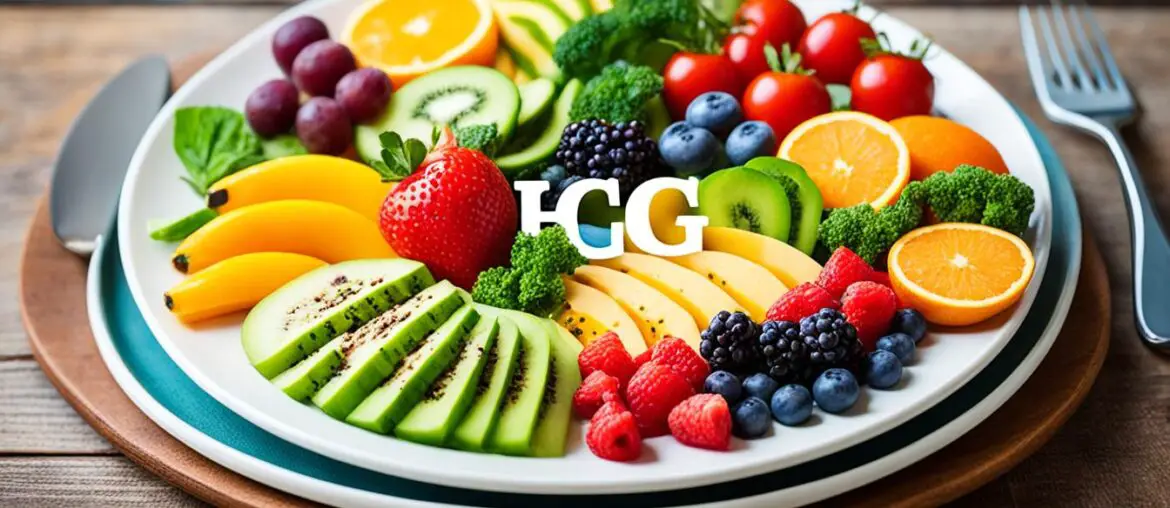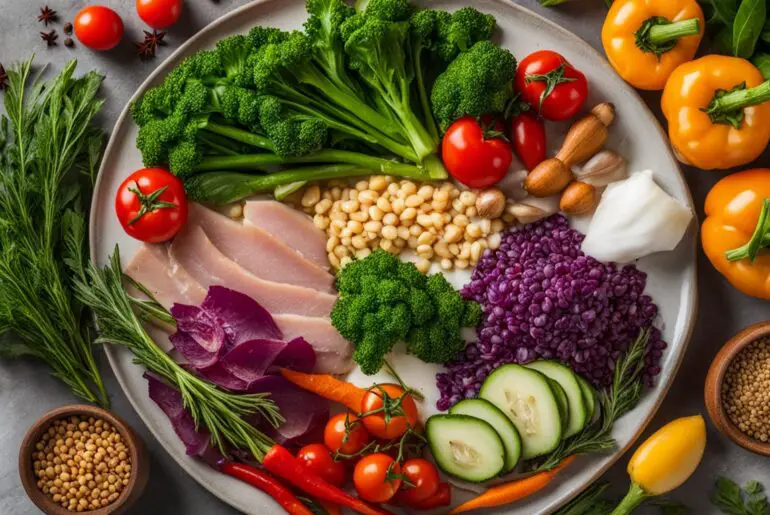Did you know that the HCG diet has gained popularity as a rapid weight loss solution? However, the key to long-term success lies in the transition phase after completing the HCG phase. In Phase 3 of the HCG diet protocol, you’ll learn how to reintroduce foods in a way that supports your health and sustains your weight loss journey.
Key Takeaways:
- The HCG protocol includes different phases, with Phase 3 being the maintenance phase.
- Reintroducing foods after the HCG phase requires following specific guidelines.
- Focus on nutrient-dense foods to nourish your body during the reintroduction phase.
- Incorporate regular exercise to support weight maintenance and overall well-being.
- Listen to your body’s cues and make choices that align with your individual health goals.
The HCG Diet Protocol
The HCG diet protocol consists of different phases, with Phase 3 being the maintenance phase. During this phase, you will start reintroducing a wider variety of foods into your diet while still maintaining certain restrictions on sugars and starches.
In Phase 3 of the HCG diet, the focus shifts from strict calorie restriction to finding a balance that supports weight maintenance. This phase is also known as the stabilization phase, as it helps your body adjust to the new weight and establish a healthy eating pattern.
While Phase 1 and Phase 2 of the HCG diet primarily involve calorie restriction and the use of HCG injections or drops, Phase 3 allows for a gradual increase in calorie intake and the reintroduction of a wider range of foods. However, it’s important to note that certain restrictions still apply to ensure the stability of your weight loss.
During this phase, you will continue to avoid added sugars and starches, such as bread, pasta, and sugary treats. The focus will be on consuming lean proteins, healthy fats, fruits, vegetables, and whole grains.
The HCG diet phase 3 foods should be nutrient-dense and provide your body with essential vitamins, minerals, and antioxidants. Including a variety of colors and textures in your meals will help ensure that you are getting a wide range of nutrients.
“Phase 3 of the HCG diet allows you to start enjoying a more varied food selection while still maintaining the progress you achieved in the previous phases.”
Reintroducing Foods in Phase 3
The reintroduction of foods in Phase 3 should be done gradually. This allows your body to adjust and helps you identify any potential food intolerances or sensitivities. Starting with small portions and observing how your body responds is essential.
Here are some recommendations for reintroducing foods during Phase 3:
- Begin by adding one new food at a time and monitor your body’s response.
- Focus on whole, unprocessed foods that are nutrient-dense.
- Include a variety of fruits and vegetables to ensure an ample intake of vitamins and minerals.
- Choose lean proteins such as chicken, turkey, fish, and tofu.
- Incorporate healthy fats like avocados, nuts, and olive oil.
Remember to keep portion sizes in check and pay attention to your body’s hunger and fullness cues. The goal is to find a balance that supports weight maintenance while nourishing your body with the nutrients it needs.
Exercise is also an essential component of maintaining weight loss during Phase 3. Regular physical activity helps boost metabolism, improve cardiovascular health, and maintain muscle mass.
Guidelines for Reintroduction
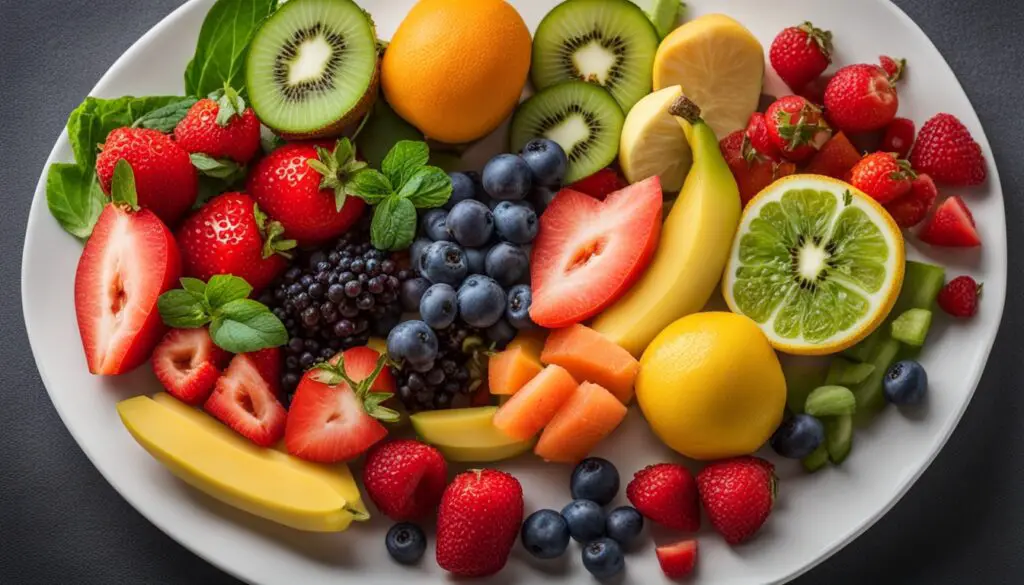
When reintroducing foods after the HCG phase, it’s important to follow certain guidelines. These guidelines will help ensure a smooth transition and maintain the progress you’ve achieved. Here are some recommendations for the reintroduction phase of the HCG protocol:
Gradually Increase your Caloric Intake
After the calorie restriction of the HCG diet, it’s important to gradually increase your calorie intake during the reintroduction phase. This gradual increase allows your body to adjust to higher calorie consumption without causing weight gain. Start by adding around 200 calories per week until you reach an appropriate maintenance level for your body. By doing so, you can find the balance that supports your health and weight goals.
Focus on Nutrient-Dense Foods
During Phase 3 of the HCG diet, prioritize nutrient-dense foods for optimal health and sustained weight loss. These foods provide essential nutrients while helping you maintain a balanced and healthy diet. Incorporate plenty of fruits, vegetables, lean proteins, and whole grains into your meals. They offer a wide range of vitamins, minerals, and fiber, supporting your overall well-being.
Stay Hydrated
Hydration is key during the reintroduction phase. Aim to drink at least 8 glasses of water per day to support digestion, metabolism, and overall health. Staying hydrated also helps prevent overeating and promotes a sense of fullness, reducing the likelihood of unnecessary snacking.
Monitor Portion Sizes
Keep an eye on portion sizes as you reintroduce foods. It’s essential to maintain a balanced approach and avoid overeating. Be mindful of your body’s signals of hunger and fullness, and listen to them as you enjoy your meals. Experiment with different portion sizes to find what works best for you in terms of satiety and satisfaction.
Incorporate Regular Exercise
In addition to following a healthy diet, regular exercise is crucial for maintaining weight loss and overall well-being. Aim for at least 150 minutes of moderate-intensity exercise per week. Engage in activities that you enjoy, such as walking, jogging, swimming, or strength training. Find a routine that fits your schedule and fitness level, and stick to it.
By following these guidelines for the reintroduction phase, you can successfully transition from the HCG phase and maintain your weight loss. Remember to listen to your body, make mindful choices, and celebrate your progress.
Recommended Foods
During Phase 3 of the HCG diet, it’s time to start reintroducing a wider variety of foods into your meals. This phase is an opportunity to expand your options while still maintaining the principles of the HCG protocol. Incorporating nutrient-dense foods is key to sustaining your weight loss and promoting overall health.
When choosing foods for Phase 3, it’s important to focus on lean proteins, healthy fats, fruits, vegetables, and whole grains. These options provide essential nutrients while still aligning with the principles of the HCG diet. Let’s explore some recommended foods to include:
- Lean Proteins: Incorporate lean protein sources such as chicken, turkey, fish, and lean cuts of beef or pork. These protein-rich foods help maintain muscle mass and support satiety.
- Healthy Fats: Include sources of healthy fats like avocado, olive oil, nuts, and seeds. These fats provide essential nutrients and promote a feeling of fullness.
- Fruits: Enjoy a variety of fruits in moderation. Opt for low-sugar options like berries, apples, and citrus fruits.
- Vegetables: Fill your plate with a colorful array of vegetables. Focus on non-starchy options like leafy greens, broccoli, cauliflower, peppers, and tomatoes.
- Whole Grains: Choose whole grains like quinoa, brown rice, oats, and whole wheat bread or pasta. These options provide fiber and additional nutrients.
By incorporating these recommended foods into your Phase 3 meals, you’ll ensure a balanced and nutrient-rich diet. Remember to monitor portion sizes and listen to your body’s hunger and fullness cues.
Gradual Increase of Calorie Intake
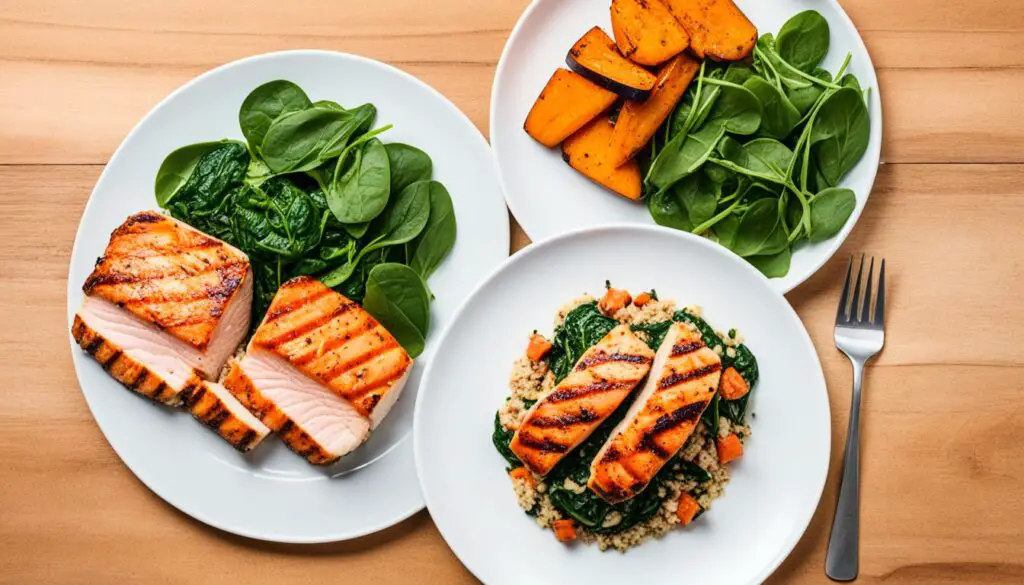
After the calorie restriction of the HCG diet, it’s important to gradually increase your calorie intake in the maintenance phase. This allows your body to adjust to higher calorie consumption without causing weight gain. To accomplish this, start adding approximately 200 calories per week until you reach an appropriate maintenance level.
“Gradually increasing calorie intake during the maintenance phase of the HCG diet helps prevent the body from going into a state of shock after the low-calorie phase. This gradual approach supports a sustainable transition and helps maintain the weight loss achieved during the diet.” – Dr. Emily Collins
During the maintenance phase, HCG maintenance phase diet, it’s crucial to focus on nutrient-dense foods that provide essential vitamins and minerals without excess calories. This ensures that your body receives the necessary fuel and remains nourished. In addition to adding calories, prioritize quality by choosing whole, unprocessed foods that contribute to your overall wellness.
By steadily increasing your calorie intake and selecting nutrient-dense foods, you create a balanced and sustainable dietary approach. Your body will adjust to the new energy levels while still maintaining the benefits of the HCG diet. Remember to track your progress, listen to your body’s signals, and make adjustments as needed to find the optimum calorie intake for your individual needs.
Benefits of Gradually Increasing Calorie Intake
A gradual increase in calorie intake during the maintenance phase of the HCG diet offers several benefits:
- Prevents rapid weight regain
- Allows the body to adjust to higher caloric levels
- Supports sustainable weight maintenance
- Helps establish a healthy eating routine
- Reduces the risk of experiencing metabolic rebound
Cautions and Considerations
While gradually increasing calorie intake is essential for a successful transition, it’s important to monitor your body’s response and make adjustments accordingly. Every individual is unique, and what works for one person may not work for another. Be mindful of any signs of weight gain, bloating, or discomfort, and consult with a healthcare professional if necessary.
| Recommended Foods | Calorie Increase (per serving) |
|---|---|
| Grilled chicken breast | 100 calories |
| Salmon fillet | 150 calories |
| Quinoa | 50 calories |
| Avocado | 80 calories |
| Spinach | 20 calories |
Focus on Nutrient-Dense Foods
During the reintroduction phase of the HCG maintenance phase diet, it is crucial to emphasize the consumption of nutrient-dense foods. These foods provide essential nutrients while helping to maintain a balanced and healthy diet.
Fruits and vegetables are excellent choices as they are packed with vitamins, minerals, and antioxidants. Incorporating a variety of colors ensures a wide array of nutrients. Include options like berries, leafy greens, bell peppers, and broccoli to maximize your nutrient intake.
Lean proteins are also important for repair and growth. Opt for options such as skinless chicken breast, lean cuts of beef or pork, fish (like salmon or tuna), and low-fat dairy products. These proteins not only provide essential amino acids but also keep you feeling full and satisfied.
Whole grains are another valuable addition to your diet. They contain fiber, vitamins, and minerals that are beneficial for overall health. Incorporate foods like whole wheat bread, brown rice, quinoa, and oatmeal into your meals to promote satiety and sustained energy levels.
You are what you eat, so focus on incorporating nutrient-dense foods into your diet during the HCG maintenance phase. These foods provide the necessary building blocks for a healthy and thriving body. – Michelle Smith, Registered Dietitian
By including a wide variety of nutrient-dense foods in your meals, you can ensure that you’re nourishing your body while maintaining the results achieved during the previous phases of the HCG diet. Remember to listen to your body’s needs and choose foods that support your overall well-being.
Incorporate Regular Exercise
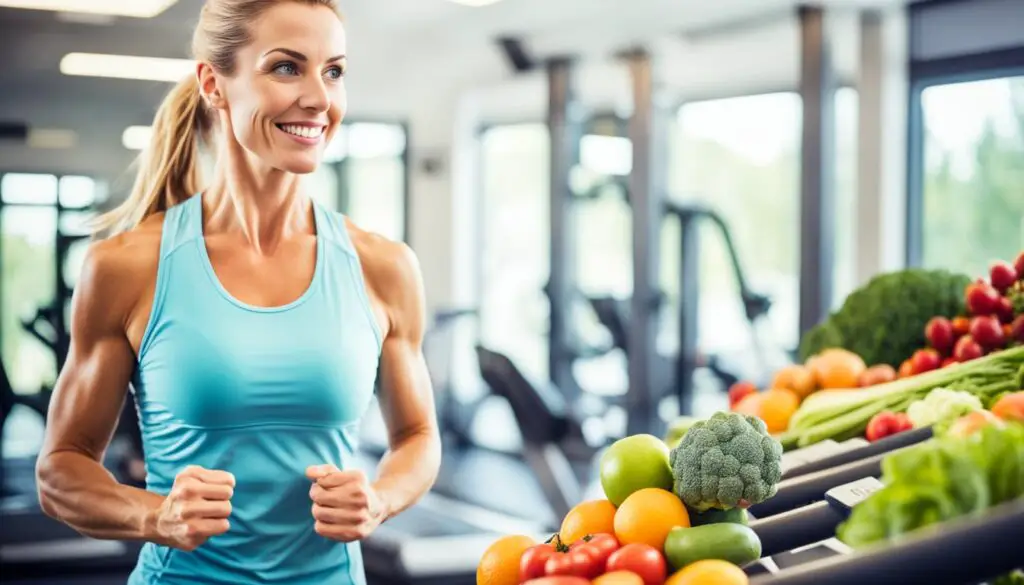
Regular exercise plays a vital role in maintaining weight loss and overall well-being during the HCG maintenance phase diet. It is recommended to aim for at least 150 minutes of moderate-intensity exercise per week. By incorporating both cardiovascular exercises and strength training into your routine, you can maximize the benefits for your body.
Cardiovascular exercises, such as brisk walking, cycling, or swimming, help elevate your heart rate, burn calories, and improve cardiovascular health. Engaging in these activities not only supports weight maintenance but also boosts your energy levels and enhances your overall endurance.
Strength training exercises, on the other hand, help build lean muscle mass while increasing your metabolic rate. This means your body continues to burn calories even at rest, aiding in weight management during the HCG maintenance phase diet. Including exercises such as weightlifting, bodyweight exercises, or resistance band workouts can help you tone and strengthen your muscles.
It’s important to find exercises that you enjoy and that fit into your lifestyle. This will help ensure long-term adherence to your exercise routine. Whether it’s outdoor activities like hiking or indoor workouts at the gym, choose activities that keep you motivated and engaged.
Exercise Tips for the HCG Maintenance Phase Diet:
- Start slowly if you’re new to exercise and gradually increase the intensity and duration of your workouts.
- Include a variety of exercises to target different muscle groups and prevent boredom.
- Listen to your body and rest when needed. Overtraining can lead to injury and hinder your progress.
- Stay hydrated before, during, and after exercise to maintain optimal performance.
“Exercise not only changes your body, it changes your mind, your attitude, and your mood.” – Unknown
Remember, consistency is key when it comes to incorporating regular exercise into your HCG maintenance phase diet. Make it a habit and prioritize your physical activity just like you do with your nutrition. Combining both a healthy diet and regular exercise will support your weight maintenance goals and contribute to a long-term healthy and balanced lifestyle.
Listen to Your Body
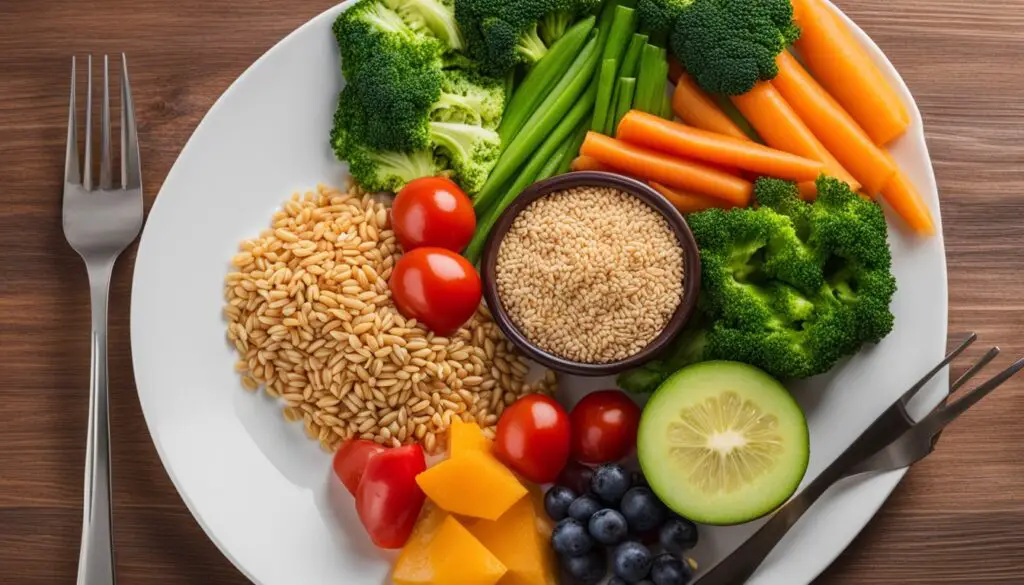
During the HCG maintenance phase diet, it’s crucial to pay close attention to how different foods make you feel as you reintroduce them. Each person’s body is unique, and what works for one person may not work for another. By listening to your body’s cues and making choices that support your individual health and well-being, you can optimize your experience during this phase.
As you start reintroducing foods, take note of any physical or emotional changes that occur after consuming certain foods. These changes can include changes in energy levels, digestion, mood, and overall well-being. Keep in mind that the goal of the maintenance phase is not only to maintain weight loss but also to establish a healthy relationship with food.
Benefits of Listening to Your Body
Listening to your body can help you identify any potential food sensitivities or allergies that may have gone unnoticed before. It can also help you determine which foods make you feel nourished, satisfied, and energized, and which ones leave you feeling sluggish or bloated.
By paying attention to how different foods make you feel, you can make informed decisions about your diet and adjust accordingly. This self-awareness empowers you to make choices that align with your personal health goals and dietary needs.
Keeping a Food Diary
One effective way to track your body’s response to different foods is by keeping a food diary. By recording what you eat and how you feel after each meal, you can identify patterns and make connections between specific foods and your body’s reactions.
Your food diary can include details such as the type of food, portion sizes, cooking methods, and any physical or emotional changes you experience. Over time, this record can help you create a personalized dietary plan that supports your overall well-being.
“By listening to our bodies, we gain valuable insight into how to nourish ourselves and maintain a healthy balance in our diets.”
Conclusion
The HCG P3 diet is a crucial phase in transitioning from the HCG weight loss protocol to a sustainable and healthy lifestyle. By following the guidelines of gradually increasing calorie intake, focusing on nutrient-dense foods, incorporating regular exercise, and listening to your body’s needs, you can maintain your weight loss success and establish long-term habits.
During the HCG P3 diet, it is important to gradually increase your calorie intake to prevent weight gain. Adding around 200 calories per week allows your body to adjust to higher calorie consumption while still maintaining your weight loss. Remember to choose nutrient-dense foods such as lean proteins, healthy fats, fruits, vegetables, and whole grains. These foods not only provide essential nutrients but also support a balanced and healthy diet.
Regular exercise should be a part of your HCG P3 diet routine. Aim for at least 150 minutes of moderate-intensity exercise per week, combining cardiovascular exercises and strength training. Exercise boosts your metabolism and helps maintain weight loss. It also promotes overall well-being and supports a healthy lifestyle.
Lastly, listen to your body. Everyone’s body is unique, and it’s important to pay attention to how different foods make you feel during the reintroduction phase. By being in tune with your body’s cues and making choices that support your individual health and well-being, you can continue to achieve long-term success with the HCG P3 diet.
FAQ
What is the HCG Diet Protocol?
The HCG diet protocol consists of different phases, with Phase 3 being the maintenance phase. During this phase, you will start reintroducing a wider variety of foods into your diet while still maintaining certain restrictions on sugars and starches.
How do I reintroduce foods after the HCG phase?
When reintroducing foods after the HCG phase, it’s important to follow certain guidelines. These include gradually increasing your caloric intake, focusing on nutrient-dense foods, staying hydrated, monitoring portion sizes, and incorporating regular exercise.
What foods can I eat during Phase 3 of the HCG diet?
During Phase 3 of the HCG diet, you can start incorporating a wider variety of foods into your meals. Recommended foods include lean proteins, healthy fats, fruits, vegetables, and whole grains. It’s important to choose nutrient-dense options while still being mindful of portion sizes.
How do I gradually increase my calorie intake?
After the calorie restriction of the HCG diet, it’s important to gradually increase your calorie intake. Start by adding around 200 calories per week until you reach an appropriate maintenance level. This gradual increase helps your body adjust to higher calorie consumption without causing weight gain.
What are nutrient-dense foods?
Nutrient-dense foods are those that provide a high amount of essential nutrients per calorie. These include fruits, vegetables, lean proteins, and whole grains. Choosing nutrient-dense options ensures that your body gets the necessary vitamins, minerals, and antioxidants while maintaining a balanced and healthy diet.
How important is regular exercise during the maintenance phase?
Regular exercise is important for maintaining weight loss and overall well-being. Aim for at least 150 minutes of moderate-intensity exercise per week and include both cardiovascular and strength training exercises. Exercise helps to boost metabolism and support weight maintenance.
Why is it important to listen to my body during the reintroduction phase?
Each person’s body is unique, so it’s important to pay attention to how different foods make you feel during the reintroduction phase. By listening to your body’s cues, you can make choices that support your individual health and well-being.

